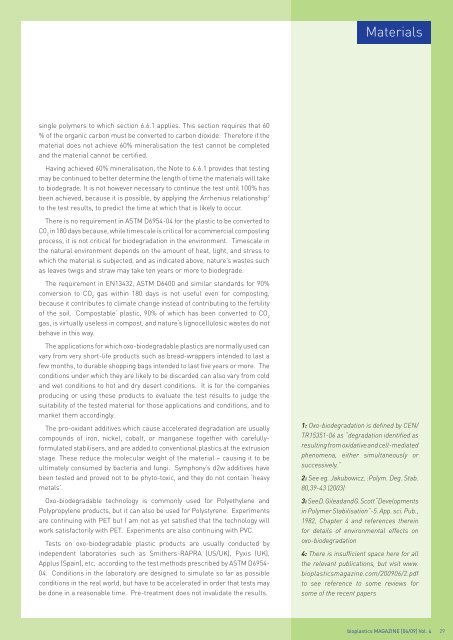bioplasticsMAGAZINE_0906
bioplasticsMAGAZINE_0906
bioplasticsMAGAZINE_0906
Create successful ePaper yourself
Turn your PDF publications into a flip-book with our unique Google optimized e-Paper software.
Materials<br />
single polymers to which section 6.6.1 applies. This section requires that 60<br />
% of the organic carbon must be converted to carbon dioxide. Therefore if the<br />
material does not achieve 60% mineralisation the test cannot be completed<br />
and the material cannot be certified.<br />
Having achieved 60% mineralisation, the Note to 6.6.1 provides that testing<br />
may be continued to better determine the length of time the materials will take<br />
to biodegrade. It is not however necessary to continue the test until 100% has<br />
been achieved, because it is possible, by applying the Arrhenius relationship 2<br />
to the test results, to predict the time at which that is likely to occur.<br />
There is no requirement in ASTM D6954-04 for the plastic to be converted to<br />
C0 2<br />
in 180 days because, while timescale is critical for a commercial composting<br />
process, it is not critical for biodegradation in the environment. Timescale in<br />
the natural environment depends on the amount of heat, light, and stress to<br />
which the material is subjected, and as indicated above, nature’s wastes such<br />
as leaves twigs and straw may take ten years or more to biodegrade.<br />
The requirement in EN13432, ASTM D6400 and similar standards for 90%<br />
conversion to CO 2<br />
gas within 180 days is not useful even for composting,<br />
because it contributes to climate change instead of contributing to the fertility<br />
of the soil. ‘Compostable’ plastic, 90% of which has been converted to CO 2<br />
gas, is virtually useless in compost, and nature‘s lignocellulosic wastes do not<br />
behave in this way.<br />
The applications for which oxo-biodegradable plastics are normally used can<br />
vary from very short-life products such as bread-wrappers intended to last a<br />
few months, to durable shopping bags intended to last five years or more. The<br />
conditions under which they are likely to be discarded can also vary from cold<br />
and wet conditions to hot and dry desert conditions. It is for the companies<br />
producing or using these products to evaluate the test results to judge the<br />
suitability of the tested material for those applications and conditions, and to<br />
market them accordingly.<br />
The pro-oxidant additives which cause accelerated degradation are usually<br />
compounds of iron, nickel, cobalt, or manganese together with carefullyformulated<br />
stabilisers, and are added to conventional plastics at the extrusion<br />
stage. These reduce the molecular weight of the material – causing it to be<br />
ultimately consumed by bacteria and fungi. Symphony’s d2w additives have<br />
been tested and proved not to be phyto-toxic, and they do not contain ‘heavy<br />
metals’.<br />
Oxo-biodegradable technology is commonly used for Polyethylene and<br />
Polypropylene products, but it can also be used for Polystyrene. Experiments<br />
are continuing with PET but I am not as yet satisfied that the technology will<br />
work satisfactorily with PET. Experiments are also continuing with PVC.<br />
Tests on oxo-biodegradable plastic products are usually conducted by<br />
independent laboratories such as Smithers-RAPRA (US/UK), Pyxis (UK),<br />
Applus (Spain), etc, according to the test methods prescribed by ASTM D6954-<br />
04. Conditions in the laboratory are designed to simulate so far as possible<br />
conditions in the real world, but have to be accelerated in order that tests may<br />
be done in a reasonable time. Pre-treatment does not invalidate the results.<br />
1: Oxo-biodegradation is defined by CEN/<br />
TR15351-06 as “degradation identified as<br />
resulting from oxidative and cell-mediated<br />
phenomena, either simultaneously or<br />
successively.”<br />
2: See eg. Jakubowicz, :Polym. Deg. Stab.<br />
80,39-43 (2003)<br />
3: See D. Gilead and G. Scott “Developments<br />
in Polymer Stabilisation”-5. App. sci. Pub.,<br />
1982, Chapter 4 and references therein<br />
for details of environmental effects on<br />
oxo-biodegradation<br />
4: There is insufficient space here for all<br />
the relevant publications, but visit www.<br />
bioplasticsmagazine.com/20<strong>0906</strong>/2.pdf<br />
to see reference to some reviews for<br />
some of the recent papers<br />
bioplastics MAGAZINE [06/09] Vol. 4 29


















